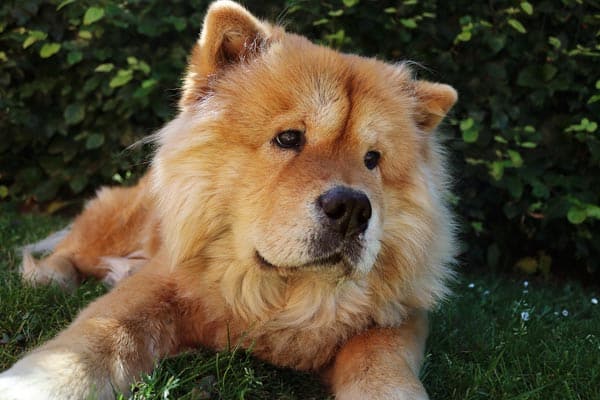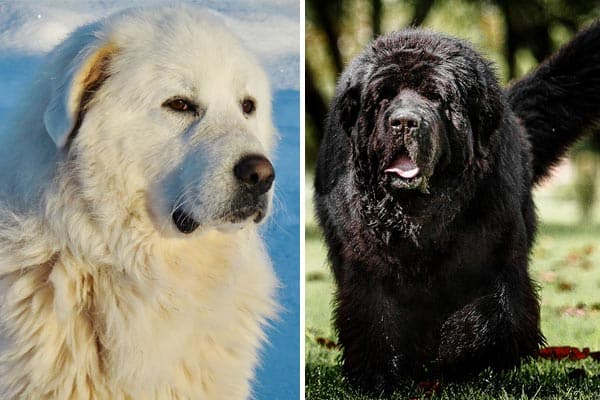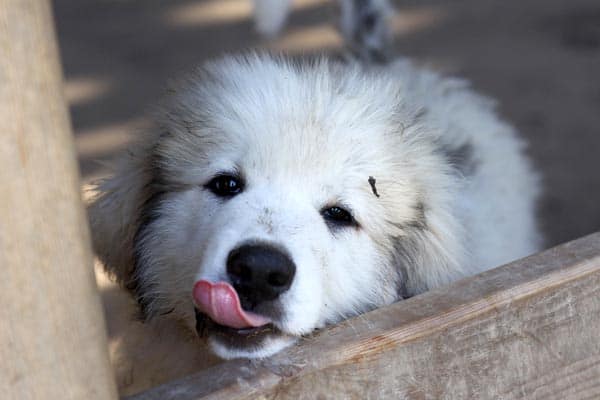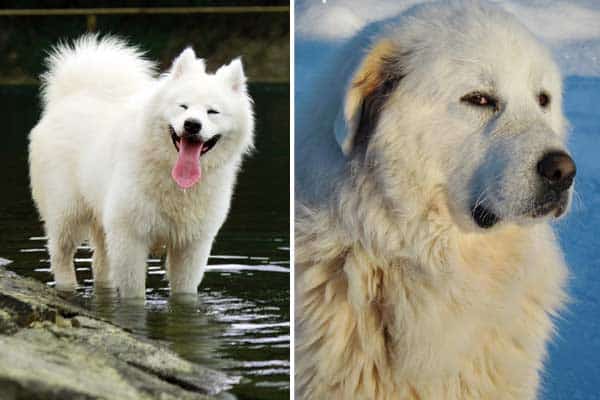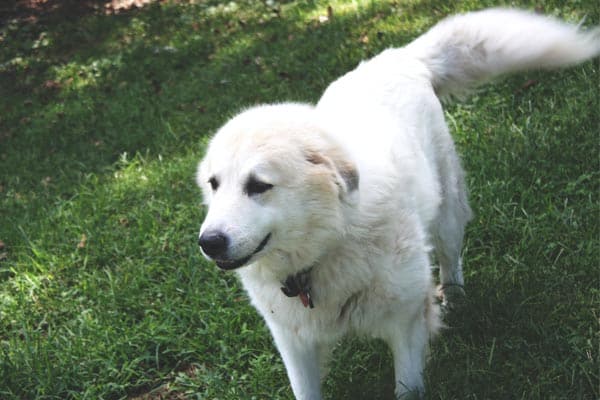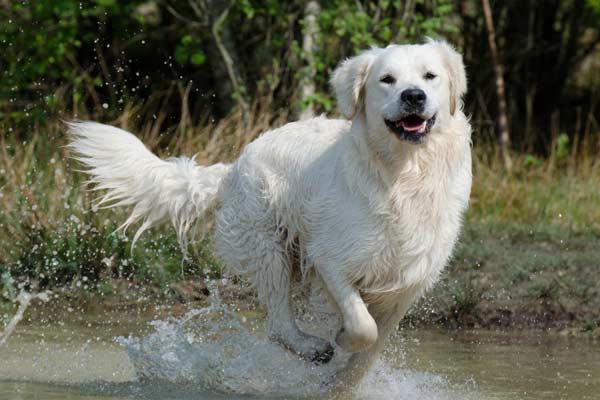Great Pyrenees Chow Mix: Great Companion for the Dedicated Owner
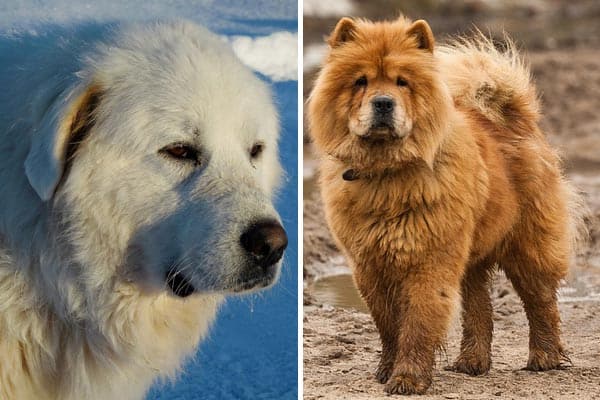
The Chownees dog combines the strength and nobility of the Great Pyrenees with the pride and scowling good looks of the Chow.
Coming in multiple colors, the Chownees makes an unusual, attractive, and steadfast companion. If you wonder who came up with the brilliant idea of mixing the two dogs or when nobody knows exactly.
A Great Pyrenees Chow mix, or Chownees, is a designer cross. Generally friendlier than most Chows and smaller than the majority of Great Pyrenees, the Chownees is a desirable fluffy family pet for many.
Some desirable traits are its proficiency as a guard dog, steady temperament, and low exercise requirements. Other than training and coat maintenance, the Chownees require no extraordinary care.
Training and socialization must be extensive to result in a manageable and civil addition to your home.
Background affects temperament and appearance
A dog’s background affects its temperament depending on its historical use. A guard dog will have a different disposition than a pet bred solely for companionship or a herding dog.
Some dogs have multiple purposes and illustrate a versatile and nonvolatile personality.
Great Pyrenees Background
The Great Pyrenees as a distinct breed originated in the Pyrenees Mountain range between France and Spain.
Considered mostly of French descent, the Pyr was developed to be a livestock guardian, deterring wolves and bears from hunting flocks of sheep.
Great Pyrenees have proven effective at protecting a variety of animals other than sheep against wolves, bears, mountain lions, foxes, and birds of prey.
Ancestors of the Great Pyrenees may include the Tibetan Mastiff and other lupomolossoids (distinguished from true Mastiffs which were ancient but further removed from wolves)
The Great Pyrenees’ predominantly white coat is thought to have originated with large, white-coated livestock guardian dogs from Asia.
Tibetan Mastiffs do not have white fur, but Great Pyrenees handlers possibly selected for the white color to help their dogs blend in better with the flocks.
Great Pyrenees have been in existence for 2500 to 3000 years. They joined the AKC in 1933 and are in the working dog group.
Chow Background
As the Great Pyrenees, the Chow Chow has been in existence for more than 2000 years. Its ancestors also came from Asia, possibly from as far north as Siberia or as far south as northern China, Mongolia, or Tibet.
Chows were developed in China to help hunt large game, as catch dogs for stray cattle and hogs, and as guard dogs for farms and palaces.
They also herded livestock to market, pulled sleds of supplies, and provided meat and pelts for the Chinese people.
Consuming dog meat was not an acceptable practice in the West, and the UK viewed the Chow as an exotic zoo exhibit when it arrived in the 1820s.
In later years, they would focus on trying to develop Chow’s qualities as a companion and show dog.
Chows are a primitive breed without much branching from wolves and with little temperamental advancement over the centuries. The Chow Chow became a member of the nonsporting group of the AKC in 1903.
Chownees History
Not as likely a product of accidental breeding as some other hybrids, the exact time of origin of the Great Pyrenees Chow Chow mix is unclear.
Most probably, the Chownees was an idea born less than 15 years ago and first conceived in the US.
Possible motivations were to make a more affectionate and social dog out of the Chow Chow or a more targeted guard dog out of the Great Pyrenees.
The other possibility is someone wanted a big Teddy bear-looking dog that was less snub-faced than a Chow but smaller than a Pyr.
What does a Great Pyrenees Chow mix look like?
Occasionally, you will get a mixed breed puppy that looks like one parent or the other. Such offspring are rare as you can almost always tell a dog of mixed heritage. Some variable qualities are listed below.
- Longer muzzle than a Chow
- Larger eyes than a Chow
- Smaller than a Great Pyrenees, a little larger than a Chow
- Less pluming and feathering than a Great Pyrenees; coat not as offstanding as a Chow
- Hocks and stifles may be unusually straight like a Chow’s
- The tongue will probably be a mix of bluish-black and pink
- Crown of head not as rounded as Great Pyrenees and stop not as pronounced as in Chow
Great Pyrenees Accepted Appearance
- Size – 25 to 32 inches tall at the shoulders, 85 to 160 pounds; females smaller than males
- Head – has a wedge shape and is neither too heavy nor too narrow; slightly rounded crown; sloping forehead with a single furrow; no obvious stop is most correct, but you will see numerous Pyrs with an apparent stop (break or angle between forehead and snout)
- Muzzle – equals back skull in length and width, tapers but does not come to a point
- Eyes – dark brown, medium-sized, almond-shaped, slightly slanted
- Ears – small or medium-sized, carried low and flat against the head; V-shaped with rounded tips
- Bite – scissor or level
- Neck – medium-long and muscular
- Shoulders – muscular, well laidback, close to the body
- Chest – moderately broad and deep
- Body – slightly longer than tall
- Back – level topline
- Croup – slightly sloping
- Hindquarters – strongly muscled, moderate angulation
- Legs – sturdy and straight; rear double dewclaws, front single dewclaws
- Feet – round, close-cupped, arched toes; rear toe out slightly
- Tail – reaches the hocks, carried low at rest, and can be carried low, high, or “making the wheel” when excited
- Substance – medium-boned
- Coat – medium-long weather resistant dense double coat; outer coat lies relatively flat; mane across shoulders and elaborate ruff around the neck; feathers on backs of legs and extensive plumage on the tail
- Accepted Colors – solid white or white with no more than 30% of coloration (gray, badger, tan, red, or gray) on ears, head, sparingly on the body, and near the base of the tail
- Gait – smooth, efficient, elegant, powerful
Chow Breed Standard
- Size – 17 to 20 inches tall, 40 to 80 pounds, females slightly smaller than males
- Head – the large relative to the body, pronounced wrinkles on the forehead; flat on top with a moderate stop; marked brows make the stop look more abrupt
- Muzzle – about one-third of head length, should not be less
- Eyes – moderate, somewhat small in size, almond-shaped, wide-spaced, and deepest with marked brows
- Ears
- Bite – scissor
- Neck – well-muscled, long enough for the dog to hold its head high, well-arched
- Shoulders – muscular, laidback, tips of shoulder blades close to each other
- Chest – broad and deep
- Body – short and compact
- Back – level topline
- Croup – broad, short, level
- Hindquarters – powerful, straight, minimal angulation in hocks or stifles (knees)
- Legs – widely-spaced in the rear, straight, strong, single dewclaws can be removed or not in the rear
- Feet – round, compact, well-padded
- Tail – high set and carried in a curl against the back
- Substance – heavy-boned
- Coat – dense double coat, medium-long (rough-coated) or short (smooth-coated); outer coat is a stand-off on rough-coated, giving the dog a fluffy appearance; feathers on backs of legs, generous feathering on the tail, ruff around the neck; smooth-coated have no ruff or feathering and the coat lies flat
- Accepted Colors – Cream, black, red, cinnamon, or blue
- Gait – straight, sharp, and quick, stilted and short in the rear
Chownees Appearance
The Great Pyrenees Chow Chow mix will typically be a medium-large dog with a dense double coat with a ruff on the neck, feathers on the backs of the forelegs, and pantaloons on the upper hind legs. It is 17 to 26 inches tall and weighs 70 to 85 pounds.
The ears can be semi-prick, upright, hang flat against the head, or be rose.
You should immediately note how your dog looks leggier and leaner than a Chow. Your dog’s eyes will usually be dark brown, but blue dogs may have amber peepers. Your dog’s tail should be well-feathered and curl over the back.
The colors for this mix include any you can see in either parent, including white, black, cream, cinnamon, blue, or red. White dogs can be solid or typically have color only on their ears.
Some dogs can also be brown or sable, and others have Urajiro markings on a red coat.
This Chow shows subtle Urajiro markings of lighter shading in stereotypical areas such as the chin, under the tail, and the throat.
Siberian Huskies and Shiba Inus are much more dramatic with white color that is also above the eyes.
It is not often even mentioned in Chows because it is so subtle. Usually, it is referred to as variable shadings of the dog’s base color.
Urajiro markings tend to be more obvious when they show up in the Great Pyrenees Chow Chow mix.
Pros and Cons of a Chownees
Reasons Not to Get a Great Pyrenees Chow Mix
- Sheds a lot especially in spring and fall
- Coat maintenance
- May bark excessively, especially at night
- Excessive protectiveness
- Difficult to train – independent, willful, and dominant
- May develop a tendency to wander off or breakthrough fences
Reasons to Get a Great Pyrenees Chow Mix
- Loyal
- Devoted, possibly to one person
- Protective – good guard dog
- Beautiful coat and fluffy look
- Not as big as a purebred Great Pyrenees
- Low exercise needs for its size
How will your Great Pyrenees Chow mix act?
A Chownees’ disposition is somewhat unpredictable. You will probably see a combination of characteristics from the Pyr and the Chow.
Your pup will blend the Great Pyrenees’ nobility, independence, affection, protectiveness, calmness, gentleness, and patience with the Chow’s proud carriage, stubbornness, suspicion, loyalty, watchfulness, aloofness, and fearlessness. You will have an intelligent dog that will be difficult to train from both sides.
Your puppy may show a tendency to bond most strongly with one person. If your dog inherits more Great Pyrenees qualities, she may be great with children and other animals.
Socializing your dog will help bring out any existing patience and tolerance for other animals. Carefully monitor your dog for individual traits rather than treating her based on preconceptions about the contributing breeds or the mix.
Socialization and training do not always overcome guarding instincts or strong predatory drives.
Caring for the Great Pyrenees Chow Mix
Caring for your Great Pyrenees Chow mix is like caring for either of the parent breeds.
Exercise
Your Chownees are likely to have a medium level of energy and activity. You should exercise her for 30 to 40 minutes a day.
When your dog is a puppy under a year of age, your primary emphasis must be on basic training and socialization. That can be part of your exercise regimen rather than in addition to it.
Dogs require mental enrichment on top of physical exertion. You can provide mind-engaging games through fetch, training, shared activities, and puzzle games.
This mix does not mind some time alone, but a bored dog may try to escape or bark excessively.
Grooming Needs of a Chownees
In addition to the normal grooming needs of all dogs such as nail trims, ear cleaning, and tooth brushing, the Chownees require regular coat maintenance.
Brushing your dog a few times a week will keep the coat from matting and attracting dirt and flies.
You will need a few different brushes to help you get through the undercoat, keep the outer fur smooth, and deal with seasonal shedding.
Feeding a Great Pyrenees Chow Chow Mix
Your dog needs about 1500 to 1850 calories of food per day depending on age and activity levels.
You should provide meat-sourced proteins, high-quality fats or oils, and vitamins and minerals. Some diets include starches, produce, and grains, and you must decide the appropriate course for your pet.
You can provide an amino acid profile ideal for your dog through a frozen raw, dehydrated, dry, or canned food diet.
Training Your Great Pyrenees Chow Mix
A Chownees require patience and persistence to train in both basic obedience and proper social etiquette.
Both Chows and Pyrs are independent which seems like willfulness to most owners. Chow Chows can be dominant while Great Pyrenees dogs are intractable once they make up their minds.
Harsh training methods will alienate your dog and possibly make him turn against you. Some mixes are sensitive, and an impatient gesture could disrupt your relationship for weeks.
Is the Chownees healthy?
The Great Pyrenees Chow mix can live 12 to 14 years.
- Entropion – eyelids turn inward
- Glaucoma – increased eye pressure
- Bloat – distended stomach turns on axis causing life-threatening changes in the body
- Luxating patella – kneecap comes out of position periodically
- Hip dysplasia
- Skin issues and allergies
- Hypothyroidism – low thyroid hormones causes dull coat, dry skin, and a lethargic attitude
